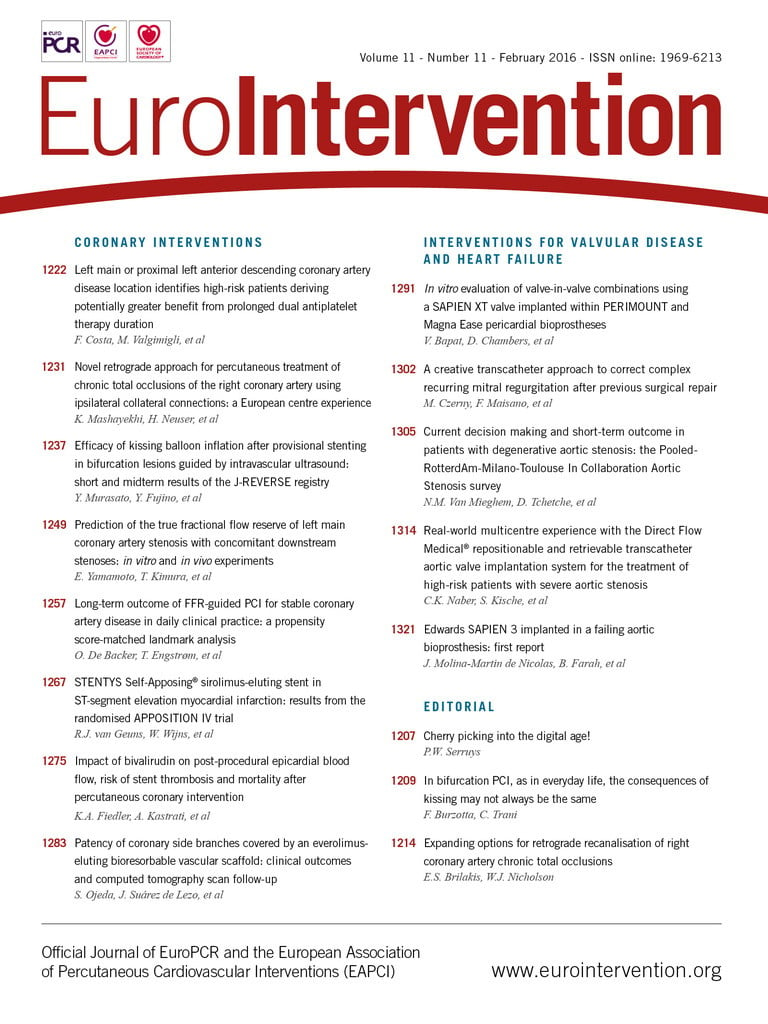
We are well into our second decade of publication, and this editorial marks another historic moment in the evolution of EuroIntervention. If you are reading this, you are reading it online, in what is the first electronic edition of the journal, signalling an increase in our publication schedule to 18 regular editions a year plus, of course, the different dedicated supplements.
And I emphasise the word “regular” because the fact that this exists only in a digital version in no way lessens the impact of the articles, or the scrutiny they go through to arrive at publication.
The same exacting quality, whether in print or online
As I look through the content of this first edition, I am impressed by the continued quality of all those who make each issue of EuroIntervention valuable, beginning with the intellectual curiosity and talents of our various authors. A quick glance at the table of contents will prove my point, and, while each of the individual articles published has an equivalent scientific value, I thought I would say a few words about my favourites.
One of the papers which attracted my attention is from our Japanese colleagues Erika Yamamoto et al, on the new assessment of the FFR in the main stem, which has always been a complex issue. In the article “Prediction of the true fractional flow reserve of left main coronary artery stenosis with concomitant downstream stenoses…”, I am very pleased to see highly experienced colleagues modelling these complex issues of FFR in the main stem and formulating new mathematical guidelines to facilitate the work of the clinician, a truly great accomplishment.
Another paper, which I find both fascinating and challenging, is the story of retrograde recanalisation in the article by Kambis Mashayekhi et al as they apply their “novel retrograde approach for percutaneous treatment of chronic total occlusions of the right coronary artery using ipsilateral collateral connections”. Using the ipsilateral collateral connections for the retrograde approach is something I always thought was strictly forbidden, as these epicardial ipsilateral collaterals are so fragile and easily broken, yet here it seems that some of our fellow interventionalists have succeeded in doing just that. Publishing the results of such a clinical success is always a great responsibility for an Editor in Chief. While we highlight this interesting technique, we must be careful not to offer importance to something that could be dangerous in the hands of less qualified operators. Nevertheless, I must emphasise that using ipsilateral collaterals as the pathway for retrograde recanalisation is really pushing the envelope. The best proof is that, out of a total of 158 patients, in the end only eight patients succeeded in gleaning a benefit from these very challenging collaterals. I hope that if complications prove to be fatal with this technique the authors will have the courage to report them.
I read with great pleasure two reports looking at valve-in-valve (ViV) implantations into old Carpentier-Edwards PERIMOUNT aortic surgical valves. The first by Vinayak Bapat et al is an in vitro study using SAPIEN XT-Magna Ease combinations in explanted calcified PERIMOUNT valves. The second, an image in cardiology by Javier Molina-Martin de Nicolas et al, uses an Edwards SAPIEN XT to treat a Carpentier-Edwards PERIMOUNT aortic bioprosthesis implanted 17 years earlier and which had become stenotic. This type of treatment is becoming more and more routine, though it is clear today that at some point we will need to stop publishing these eye-catching images and concentrate on what we truly need, a series demonstrating the short- and long-term results of this technique. Still, obviously interventional cardiology, from time to time, bails out chronic failures of surgery…it is somewhat the world upside down!
Along the same lines, I was amused by the case report by Martin Czerny et al concerning two MitraClips implanted successfully, after which the operator discovered an additional leak in the centre of an anterior mitral leaflet and, believe it or not, closed that hole using an 8 mm AMPLATZER ASD septal occluder device (AMPLATZER™ Septal Occluder; St. Jude Medical, St. Paul, MN, USA). I think the ingenuity of our interventional cardiologists knows no bounds!
How long?
On a somewhat more serious note, it seems that in the world today there are still two distinct clubs: the first is made up of those who want to abbreviate DAPT treatment, and the second of the others who want to prolong it. At the present time there exist approximately 14 trials, equally distributed between the two camps: seven promoting prolongation, seven promoting abbreviation.
Bleeding is obviously considered to be a dangerous nuisance, sometimes fatal, but historically this concept was seen to occur at the time of the stent event itself. We should never forget that atherothrombosis is a term introduced by Valentin Fuster and is a phenomenon associated with the ageing process. In this light, it is obvious that we are facing a dilemma in placing stents in ageing individuals, and thus it is no surprise to see that the community is divided regarding which DAPT strategy to adopt. Lesions, technique, age, race, comorbidities, diseases of the homeostasis, atrial fibrillation and so on…all these factors play a role. It is really to the merit of the group of Marco Valgimigli in addressing one specific aspect of these concerns - the proximal LAD and main stem.
AsiaIntervention
Finally, at the meeting in Singapore of AsiaPCR/SingLive, we had the pleasure of meeting with all the editors of AsiaIntervention. This journal is literally just now coming to life. We need, of course, more exposure and I suggested that, at the different PCR meetings and events, a slide announcing AsiaIntervention be displayed in conference rooms prior to the opening of each session. Our Japanese friends have been very active in this new journal, but now we see it is the turn of everyone across Asia to get involved. I am sure within two or three years AsiaIntervention will be very important for the region.

